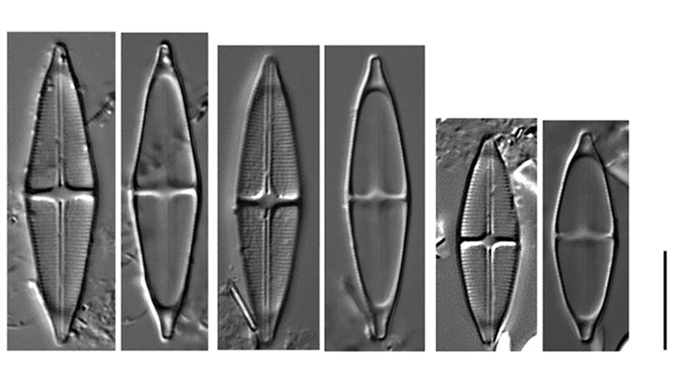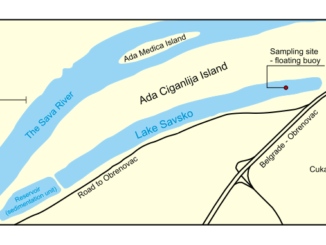
Paper category: Short communication
Corresponding author: Ivana Trbojević (itrbojevic@bio.bg.ac.rs)
DOI: 10.2478/ohs-2019-0038
Received: 22/01/2019
Accepted: 26/04/2019
Full text: here
Citation (APA style): Trbojević, I., Simić, G. & Krizmanić, J. (2019). Rare diatom Stauroneis balatonis Pantocsek recorded in Lake Savsko, Serbia. Oceanological and Hydrobiological Studies, 48(4), pp. 436-441. Retrieved 10 Dec. 2019, from doi:10.2478/ohs-2019-0038
Abstract
Although well represented in the fossil diatom flora throughout Europe and Asia, from the early-middle Miocene to the Quaternary, Stauroneis balatonis is considered a very rare diatom with a contemporary distribution limited to two ancient lakes – Ohrid and Prespa. The objective of this study was to describe the first finding of S. balatonis in Serbia in Lake Savsko and to update information on the distribution and ecology of this rare species. Periphyton samples were collected from artificial substrates incubated at three depths (0.5 m, 0.8 m and 1.4 m) in Lake Savsko and the epilithic community was sampled in the littoral zone. Samples were collected weekly in summer 2014, from mid-July to mid-September. Diatom permanent slides were prepared and small numbers of S. balatonis specimens were observed only in samples collected in September from artificial substrates incubated at the greatest depth
(1.4 m). Our results significantly contribute to the information on the contemporary distribution and the ecology of this rare diatom taxon, especially considering the fact that S. balatonis specimens were observed in our study in diatom communities developed on artificial substrates and in an urban reservoir, i.e. Lake Savsko.
References
Andrejić, J., Krizmanić, J. & Cvijan, M. (2012). Diatom species composition of the Nišava River and its tributaries Jerma and Temska Rivers (Southern Serbia). Arch. Biol. Sci. 64(3): 1127–1140. DOI:10.2298/ABS1203127A.
APHA (1995). Standard Methods for the Examination of Water and Wastewater 19th Edition. Washington, DC: American Public Health Association.
Bishop, I. (2016). Stauroneis smithii var. incisa. Retrieved November 22, 2018, from https://diatoms.org/species/stauroneis_smithii_var._incisa.
Buczkó, K., Vörös, L. & Cserny, T. (2005). The diatom flora and vegetation of Lake Balaton from sediment cores according to Márta Hajós’s legacy. Acta Bot. Hung. 47(1–2): 75–115. DOI: 10.1556/ABot.47.2005.1-2.10.
Falasco, E., Bona, F., Isaia, M., Piano, E., Wetzel, C.E. et al. (2015). Nupela troglophila sp. nov. an aerophilous diatom (Bacillariophyta) from the Bossea cave (NW Italy), with notes on its ecology. Fottea 15(1): 1–9. DOI: 10.5507/fot.2015.001.
Hofmann, G., Werum, M. & Lange-Bertalot, H. (2013). Diatomeen im Süßwasser – Benthos von Mitteleuropa. Königstein: Koeltz Scientific Books.
Hustedt, F. (1959). Die Kieselalgen Deutschlands, Österreichs und der Schweiz unter Berücksichtigung der übrigen Länder Europas sowie der angrenzenden Meeresgebiete. In L. Rabenhorst (Ed.), Kryptogamen Flora von Deutschland, Österreich und der Schweiz (pp. 737–845). Leipzig: Akademische Verlagsgesellschaft m.b.h.
Kobayasi, H. & Ando, K. (1978). New species and new combinations in the genus Stauroneis. Jap. J. Phycol. 26: 13–18.
Krasske, K. (1932). Diatomeen aus dem Oberpliocän von Willershausen. Arch. Hydrobiol. 24(3): 431–448.
Krizmanić, J. (2009). Floristic, taxonomic and ecological studies of raphid diatoms (Bacillarophyceae. Bacillariophycideae. Bacillariophyta) in Serbia. Unpublished doctoral dissertation, University of Belgrade, Belgrade, Serbia. (In Serbian).
Krizmanić, J., Ilić, M., Vidaković, D., Subakov-Simić, G., Petrović J. et al. (2015). Diatoms of the Dojkinci River (Stara Planina Nature Park, Serbia). Acta Bot. Croat. 74(2): 317–331. DOI: 10.1515/botcro-2015-0022.
Lange-Bertalot, H. & Metzeltin, D. (1996). Indicators of oligotrophy: 800 taxa representative of three ecologically distinct lake types: Carbonate buffered, Oligodystrophic, Weakly buffered soft water. In H. Lange-Bertalot (Ed.), Iconographia diatomologica (Vol. 2). Königstein, Germany: Koeltz Scientific.
Lange-Bertalot, H., Hofmann, G., Werum, M. & Cantonati, M. (2017). Freshwater Benthic Diatoms of Central Europe: Over 800 Common Species Used in Ecological Assessment. Schmitten-Oberreifenberg, Germany: Koeltz Botanical Books.
Levkov, Z., Tofilovska, S., Jovanovska, E., Cvetkoska, A. & Metzeltin, D. (2016). Revision of the Stauroneis smithii Grunow (Bacillariophyceae) species complex from Macedonia. Botanica Serbica 40(2): 167–178. DOI: 10.5281/zenodo.162215.
Mićković, B., Nikčević, M., Grozdić, T., Pucar, M. Hegediš, A. et al. (2014). Ecological potential assessment of Sava Lake based on fish community composition: Preliminary results. Water Research and Management 4(3): 21–25.
Pantocsek, J. (1902). Kieselalgen oder Bacillarien des Balaton. Resultate der Wissenschaftlichen Erforschung des Balatonsees, herausgegeben von der Balatonsee Commission der Ung. Wien: Geographischen Gesellschaft, Commissionsverlag von Ed. Hölzel.
Peveling, R., Brämick, U., Densky, H., Parr, B. & Pietrock, M. (2015). Initial characterization of Lakes Prespa, Ohrid and Shkodra/Skadar. Eschborn, Germany: Deutsche Gesellschaft für Internationale Zusammenarbeit (GIZ) GmbH.
Round, F.E., Crawford, R.M. & Mann, D.G. (1990). The diatoms: biology and morphology of the genera. Cambridge: Cambridge University Press.
Taylor, J.C., de la Rey, P.A. & van Rensburg, L. (2005). Recommendations for the collection preparation and enumeration of diatoms from riverine habitats for water quality monitoring in South Africa. Afr. J. Aquat. Sci. 30(1): 65–75. DOI: 10.2989/16085910509503836.
Temniskova-Topalova, D. & Ognjanova-Rumenova, N. (1997). Description, comparison and biostratigraphy of the nonmarine Neogene diatom floras from Southern Bulgaria. Geologica Balcanica 27(1–2): 57–81.
Trbojević, I. (2018). Analysis of periphyton developed on artificial substrates in the Sava Lake and the Vrutci Lake. Doctoral dissertation, University of Belgrade, Belgrade, Serbia. Available at: http://nardus.mpn.gov.rs/handle/123456789/10710?locale-attribute=en
(In Serbian).
Trbojević, I., Jovanović, J., Kostić, D., Popović, S., Krizmanić, J. et al. (2017). Structure and succession of periphyton in an urban reservoir: artificial substrate specificity. Oceanolgical and Hydrobiological Studies 46(4): 379–392.
Uherkovich, G. (1996): Data to the knowledge for the algal vegetation of the sediment surface in Lake Balaton. Hungary. Somogyi múzeumok közleményei, Kaposvár. 12: 223–255. (In Hungarian).
Van de Vijver, B., Beyens, L. & Lange-Bertalot, H. (2004). The genus Stauroneis in Arctic and Antarctic Regions. In H. Lange-Bertalot & P. Kociolek (Eds.), Bibliotheca Diatomologica (Vol. 51). Berlin-Stuttgart, Germany: J. Cramer.
Vidaković, D., Krizmanić, J., Šovran, S., Stojanović, K. & Đorđević, J. (2015). Diatom species composition of the Raška River (Southwestern Serbia). Matica Srpska Journal of Natural Sciencies 128: 29–40 .
Werum, M. & Lange-Bertalot, H. (2004): Diatoms in springs from Central Europe and elsewhere under the influence of hydrologeology and anthropogenic impacts. In H. Lange-Bertalot (Ed.), Iconographia Diatomologica (Vol. 13). Ruggell: A.R.G. Gantner Verlag K.G.



Bądź pierwszy, który skomentuje ten wpis